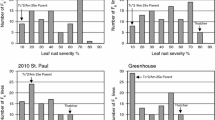Abstract
The leaf rust resistance gene, Lr18, of common wheat cultivars has been derived from Triticum timopheevi and is located on chromosome arm 5BL. Chromosome banding (N-banding) analyses revealed that in the wheat cultivars carrying Lr18 that were examined, which had been bred in 6 different countries, chromosome arm 5BL possessed a specific terminal band not carried by their susceptible parental cultivars. It was suggested that this terminal N-band was introduced from T. timopheevi together with Lr18. N-banding analysis of a T. timopheevi strain showed that one of two timopheevi chromosomes had provided Japanese wheat lines containing Lr18 with the terminal band.
Similar content being viewed by others
References
Badaeva ED, Budashkina EB, Badaev NS, Kalinia NP, Shkutina FM (1991) General features of chromosome substitutions in Triticum aestivum x T. timopheevi hybrids. Theor Appl Genet 82:227–232
Endo TR, Gill BS (1984) Somatic karyotype, heterochromatin distribution, and nature of chromosome differentiation in common wheat, Triticum aestivum L. em Thell. Chromosoma 89:361–369
Friebe B, Hatchett JH, Gill BS, Mukai Y, Sebesta EE (1991) Transfer of Hessian fly resistance from rye to wheat via radiation-induced terminal and intercalary chromosomal translocations. Theor Appl Genet 83:33–40
Gerlach WL (1977) N-banded karyotype of wheat species. Chromosoma 62:49–56
Gill BS, Kimber G (1974) Giemsa C-banding and the evolution of wheat. Proc Natl Acad Sci USA 71:4086–4090
Gill BS, Kimber G (1977) Recognition of translocations and alien chromosome transfers in wheat by the Giemsa C-banding technique. Crop Sci 17:264–266
Kamio M, Mukade K (1969) Fluctuation of resistance reaction to inoculated leaf rust races of wheat seedlings under controlled temperature (in Japanese). Quick Rep Tohoku Natl Agric Exp Stn 10:1–6
McIntosh RA (1983) Genetic and cytogenetic studies involving Lr18 for resistance to Puccinia recondita. In: Sakamoto S (ed) Proc 6th Int Wheat Genet Symp. Maruzen, Kyoto, Japan, pp 777–783
Mclntosh RA (1988) Catalogue of gene symbols for wheat. In: Miller TE, Koebner RMD (eds) Proc 7th Int Wheat Genet Symp. Bath Press, Bath, UK, pp 1225–1323
Mukade K, Kamio M, Hosoda K, Watanabe Y, Kokubun K (1969) Breeding wheat strains resistant to leaf rust by interspecific hybridization (in Japanese). Jpn J Breed 19 [Suppl 2]:169–170
Sharma HC, Gill BS (1983) Current status of wide hybridization in wheat. Euphytica 32:17–31
Watanabe Y, Mukade K, Yamada M, Saito S, Kokubun K, Takahashi K, Takahashi H (1959) Studies on the breeding of leaf-rust resistant varieties of wheat by the hybridization, interspecific or intergeneric. 1. A successful transfer of the leaf-rust resistance genes to common wheat variety from Triticum timopheevi (in Japanese with English summary). Bull Tohoku Natl Agric Exp Stn 16:39–54
Yamada M, Takahashi K, Takahashi H (1960) On the physiologic races of wheat leaf rust, Puccinia recondita tritici, in Japan in 1952–1958 (in Japanese with English summary). Bull Tohoku Natl Agric Exp Stn 20:42–69
Author information
Authors and Affiliations
Additional information
Communicated by J. W. Snape
Rights and permissions
About this article
Cite this article
Yamamori, M. An N-band marker for gene Lr18 for resistance to leaf rust in wheat. Theoret. Appl. Genetics 89, 643–646 (1994). https://doi.org/10.1007/BF00222461
Received:
Accepted:
Issue Date:
DOI: https://doi.org/10.1007/BF00222461




